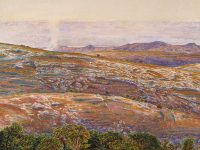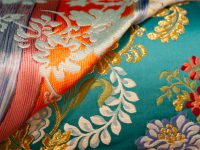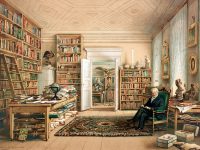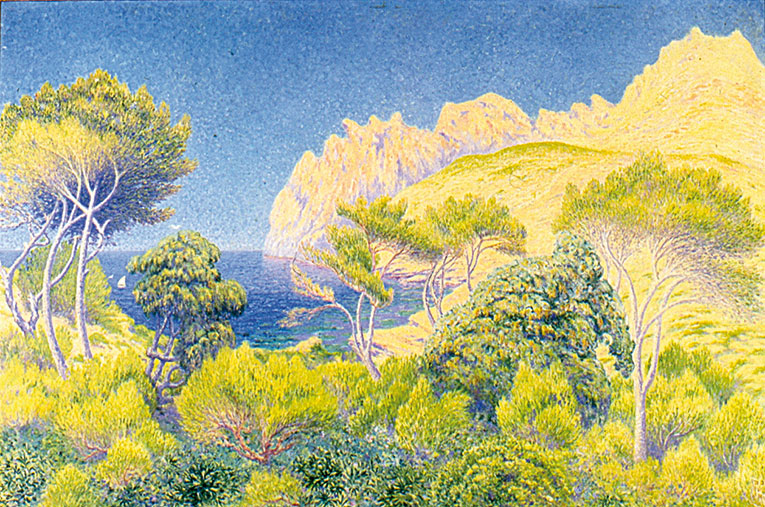 Photograph: Joan Torres. Arxiu Gran Enciclopedia de la Pintura i l’Escultura a les Balears Photograph: Joan Torres. Arxiu Gran Enciclopedia de la Pintura i l’Escultura a les BalearsThe Belgian painter William Degouve de Nuncques painted part of the Mallorcan coastline. Above, how he saw Cala Sant Vicenç. William Degouve de Nuncques. Cala de Sant Vicenç, ca. 1901. Oil on canvas, 170 x 111 cm. |
||
The ability of paint to create mythical spaces is reflected in works featuring the Balearic coves, with artists like Santiago Rusiñol, Degouve de Nuncques or Joaquim Mir. However, these paintings have not managed to raise public awareness of the value of the landscape, and many of these places have not been spared the impact of tourism and construction. |
||
|
Visitors and Mallorcans on the landscape There can be no real doubt about the role landscape has played in Mallorcan painting of the nineteenth and twentieth centuries. True to say, it would be quite unacceptable to confine this genre to the history of that glorious period nor, equally so, to believe that subsequent landscape painting does not deserve any special attention. In so doing we would overlook Miquel Brunet, Jaume Mercant, Juli Ramis…, and even Miquel Barceló himself. However, it is true that when it comes to the ability of painting to create mythical spaces, these artists –mostly visitors during the late nineteenth and early twentieth centuries– made us especially aware of how they conquered the light, helping to bring Mallorcan painting in line with movements prevalent on the continent. At this first stage, figures like Santiago Rusiñol, Degouve de Nuncques or Joaquim Mir bear special weight in this modernisation process. The influence of Anglada Camarasa was to arrive somewhat later, shaking up a painting style prone to inertia. Camarasa, who –at the outbreak of the Great War– had almost completed his French period and settled on the island, accompanied by a cohort of disciples and apostles. Through art, in the Mediterranean, Mallorca appears in more greatly defined strokes, a cultural landmark to which we are still debtors, despite the tendency to forget the fruits of culture, which are systematically ignored. It is fair to say that Mallorcan painting could follow its own path, thus, apart from these two main trends, there is a long list of artists who painted on the island, from Francisco Bernareggi, with works like Cala Figuera, to Bernhard Gutmann and scores of others, many of whom await studying in relation to our land. But it is not just the influence on our painters we wish to remark here, but rather their contribution to the perception of the landscape, a landscape created by the inhabitants of Mallorca, our ancestors. |
«Coves invite us to create the image of our relationship with the sea, and describe more than any other natural form the parable of man on Earth» |
|
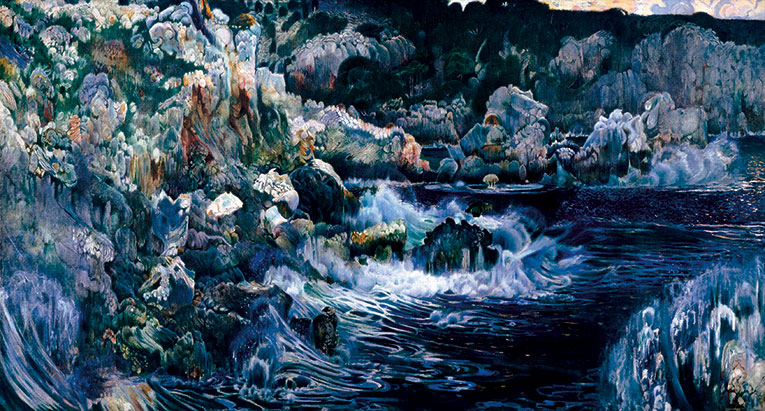 Col·lecció Aena d’Art Contemporani Col·lecció Aena d’Art ContemporaniCala de Sant Vicenç (north of Mallorca) represented in The Enchanted Cove. In this painting, Joaquim Mir invites us to reflect on man’s relationship with the sea. Joaquim Mir. The Enchanted Cove, ca.1901. Oil on canvas, 502 x 271 cm. |
||
|
The perceived landscape The landscape, how the physical reality of a country is perceived, obviously did not spring upon us with the arrival of the abovementioned foreign artists, mainly Catalans whose artistic evolution accelerated in our artistic environment. Some islanders who were painters had been successful, though their remoteness from modernity deprive them of a foundational role. Furthermore, the Renaixença (Catalan revivalist movement) had already created mythical literary spaces from certain landscapes and exceptionally from some items bestowed with particular symbolic strength. L’olivera by Pons Gallarza and, later on, El pi de Formentor by Costa Llobera, or the mutilated tree or the county girl coming down from Alcover’s mountain range had laid the foundations for a profound literary relationship with a land that Art was beginning to contemplate as image and symbol of a past and a destiny. We could say that geography becomes a landscape when someone transmits it, in search of questions or answers, denials or claims, which go beyond the physical nature of the medium. The great Ibizan poet Marià Villangómez Llobet wrote «La lengua dice la patria» (The language denotes the homeland), but the landscape shapes its image. The landscape also denotes the homeland, and this is because our gaze turns the earth into a spiritual matter. We should not forget, however, how limited the influence of the Renaixença poets was or of the golden age of island poetry. The landscape was a conquest of culture-oriented sensitivity, but while this culture had a rich scope in terms of its reception, its scope was impoverished by its demographic reach. Over the years, this scope has not expanded in line with demographics or GDP, a dysfunction that would lead to the dramatic reality of a wealth that did not create progress, and has inspired dismal reflection, especially because nothing in the current scenario would indicate any willingness to take on a new direction. Travellers and coves Once more we should allude to nineteenth-century travellers, who created and spread throughout Europe the image of Mallorca, in particular, but also of Menorca and Ibiza. They did so through their descriptions, usually accompanied by black and white illustrations –colour took a while to arrive– and of varied quality. They were unable to resist the call of our light, about which all sorts of explanations arose, these being more legendary than scientific, but in any case, they helped boost the image of places like Cala de Sant Vicenç, Cala Figuera de Santanyí, the ports of Sóller and Pollença or the Pareis Torrent (in Sa Calobra), which were to eventually become mythical spots, pantheistic temples to worship nature. Cala de Sant Vicenç, in the north of the island, is the quintessential mythical spot created by painting. Artists like Joaquim Mir and Degouve de Nuncques dedicated artworks to it. But this is not owing to the eloquence of the cliffs alone, nor to the battle between sea and land, implied or explicit. It is due, in the first instance, to its being a cove. This fortunate geographic accident invites us –invites the artist– to create an image of our relationship with the sea and, while at the same time –specifically by indicating bounds– it becomes an infinite metaphor, or symbolic stage set –The Enchanted Cove by Joaquim Mir– and because it describes more than any other natural form the parable of man on Earth. |
«Painting has taught us to see the land through others’ eyes, has shown us how to turn some spots into sacred places, sacred because the Earth has chosen them to tell us something that is not told elsewhere» |
|
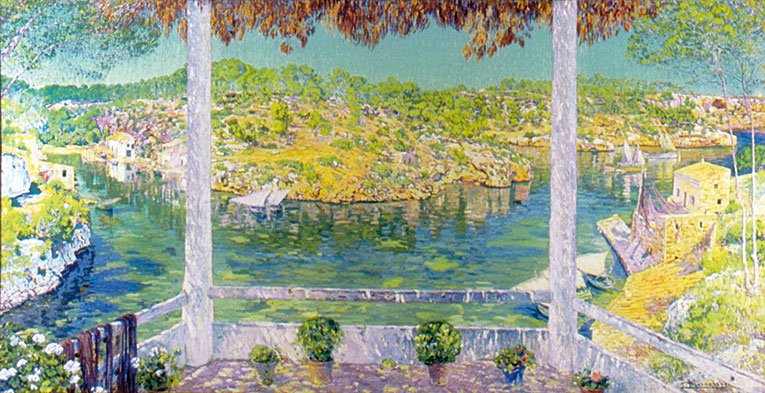 Fotografia: Joan Torres. Arxiu Gran Enciclopedia de la Pintura i l’Escultura a les Balears Fotografia: Joan Torres. Arxiu Gran Enciclopedia de la Pintura i l’Escultura a les BalearsCala Figuera Santanyí, south of the island, immortalised by Francisco Bernareggi the Argentine painter. Cala Figuera, 1934. Oil on canvas, 201 x 102 cm. |
||
|
Learning to look at Paradise Learning to look is fundamental in the evolution of a human community. We could say that, thanks to this lesson and despite some tampering of shared vision, we islanders have attained an imago mundi from the geographical and human elements with which we feel intimately linked. In a way, we could say that the advent of looking has given us a glimpse of a paradise that can now only be dreamed of, based on the reversibility of the works of men that prevent simple foreshadowing. Coves are the spots where this paradise is revealed to us. Painting has taught us to see the land through other eyes, has shown us how to turn some spots into sacred places, sacred because the Earth has chosen them to tell us something that is not told elsewhere. This argument sparked some popular movements aiming to prevent building on the Truro dunes, which Edward Hopper had memorably represented on canvas. It is obvious that these landscapes speak of the silence of the world. Locals believe that Hopper consecrated this spot, the light and the air of freedom, when he transferred them to the canvas. Art, great art, chooses altars in nature. Thus, once we have seen it through art, we can never again look at it without feeling the breath glowing from the canvas. Art’s ability to transform things and feelings is infinite: a peaceful still life by Zurbaran stirs the highest spiritual intensity, as does Jackson Pollock’s tormented dripping. |
«No hi ha hagut una societat civil suficientment sensible i culta com per impedir els impactes que dinamiten aquests espais mítics, en els quals tots ens hauríem de poder reconèixer» |
|
|
Frustrated landscapes? It is unnecessary to list all the artists who, by casting their gaze upon it, have contributed to consecrating our land. As for creating these pantheistic-sounding altars of nature, examples like the Cala de San Vicenç reach us with such a magnificent artistic aura that we are surprised by the actual cove, which appears distant due to the greedy vulgarity, the ideal, created by the greatest landscape painters, be they from home or abroad. Unlike what happened in Truro, here we lack a civil society sensitive and educated enough to prevent the impacts that obliterated these mythical spots. In our society the role of painting –and landscapes in particular– has not become as decisive as we might have expected. One might wonder whether this is an important reason why we did not learn to look by ourselves, but rather did so through others’ eyes. Possibly by creating a landscape based on the admiration the island awoke in visitors, we tainted the materials with which we built it, and this landscape was born as a commodity rather than as spiritual heritage. If this were to be the case, our responsibility would be all the greater because, unlike other countries, our landscape would also have been revealed to us through painting. |
«Through art, in the Mediterranean, Mallorca appears in more greatly defined strokes, a cultural landmark to which we are still debtors» |
|
Bibliography
Frontera, G., 1996-1998. Gran enciclopèdia de la pintura i escultura a les Illes Balears. Promomallorca. Palma.
Frontera, G., 2011. El paisatge, una construcció cultural. Opening address for the Academia de Bellas Artes de San Sebastián. 6 October, 2011.

